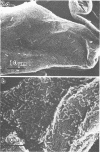Abstract
Fifteen Aeromonas isolates from various human infections and nine isolates from polluted water were identified as either Aeromonas hydrophila or Aeromonas sobria and examined for cytotoxigenicity, enterotoxigenicity, adherence to epithelial cells, and other virulence-associated factors, including proteases, lipases, elastases, and hemolysins. Two groups of organisms (I and II) were distinguishable based on differences in median lethal doses in mice and cytotoxicity for Y-1 adrenal cells. Group I clinical and environmental strains had median lethal doses of less than 10(7) colony-forming units, were cytotoxic, frequently possessed several virulence-associated factors, and had lysine decarboxylase-positive or Voges-Proskauer-positive phenotypes or both. Piliation of Aeromonas was associated strongly with ability to adhere to human buccal cells, and these characteristics were associated with group I strains. Group II clinical and environmental strains had median lethal doses of greater than or equal to 10(7) colony-forming units, were not cytotoxic, and usually were lysine decarboxylase negative or Voges-Proskauer negative or both. Clinical strains in group II exhibited enterotoxigenicity, which was not detected in group II environmental strains. A sobria was more frequently associated with human infections; 13 of the 15 clinical strains were A. sobria, and 2 were A. hydrophila. On the other hand, the majority of the environmental strains (seven of nine) were A. hydrophila.
Full text
PDF

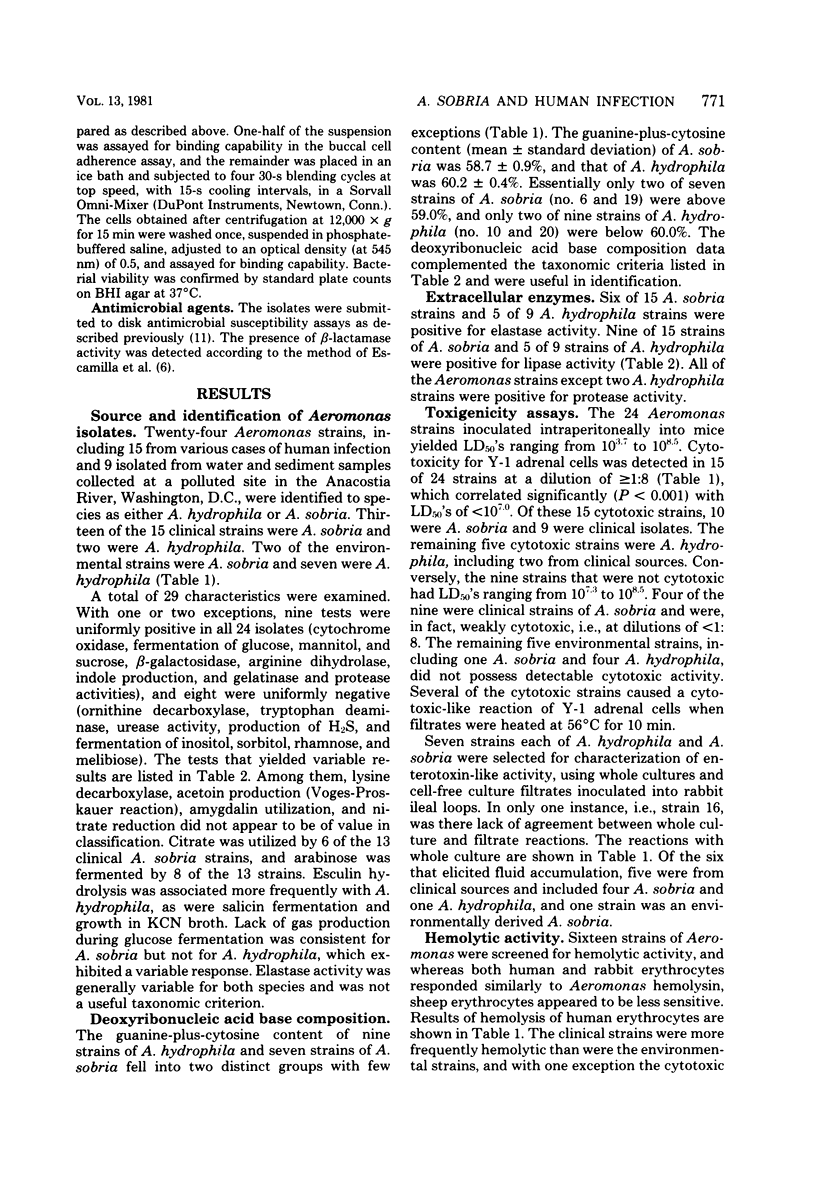
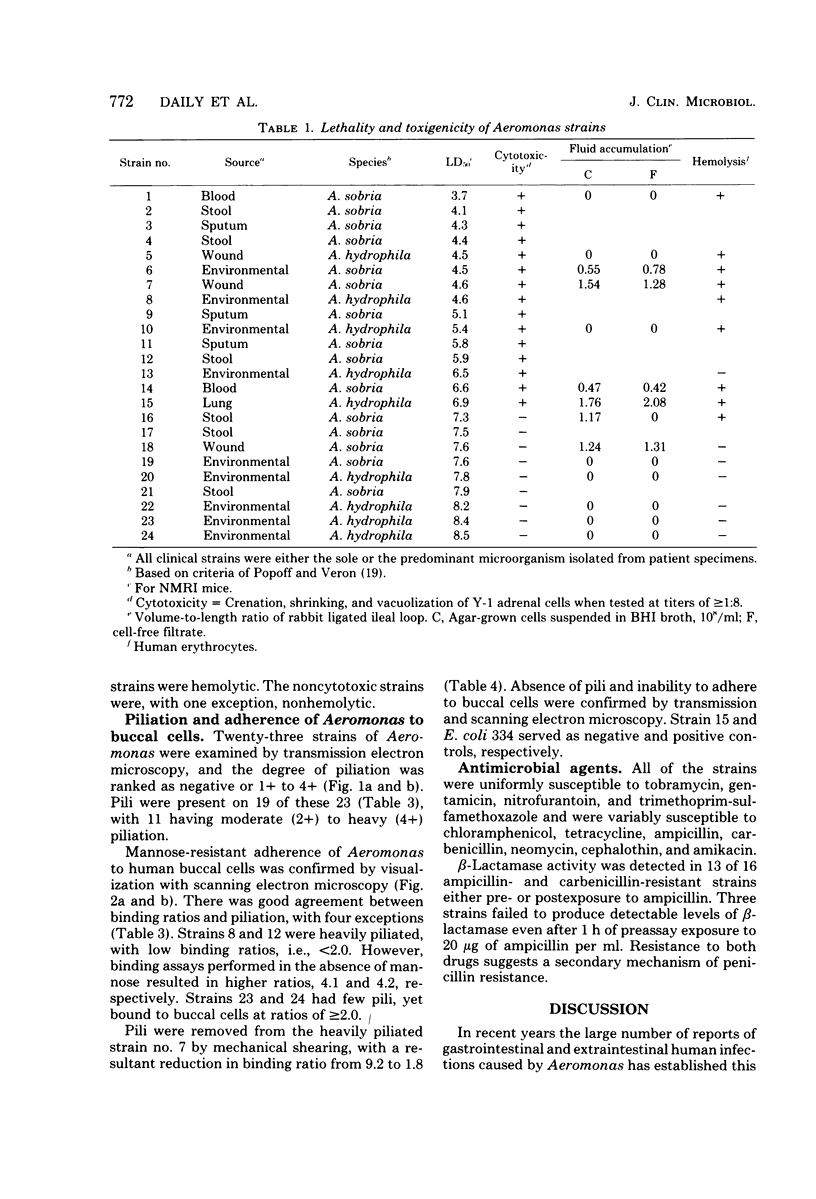
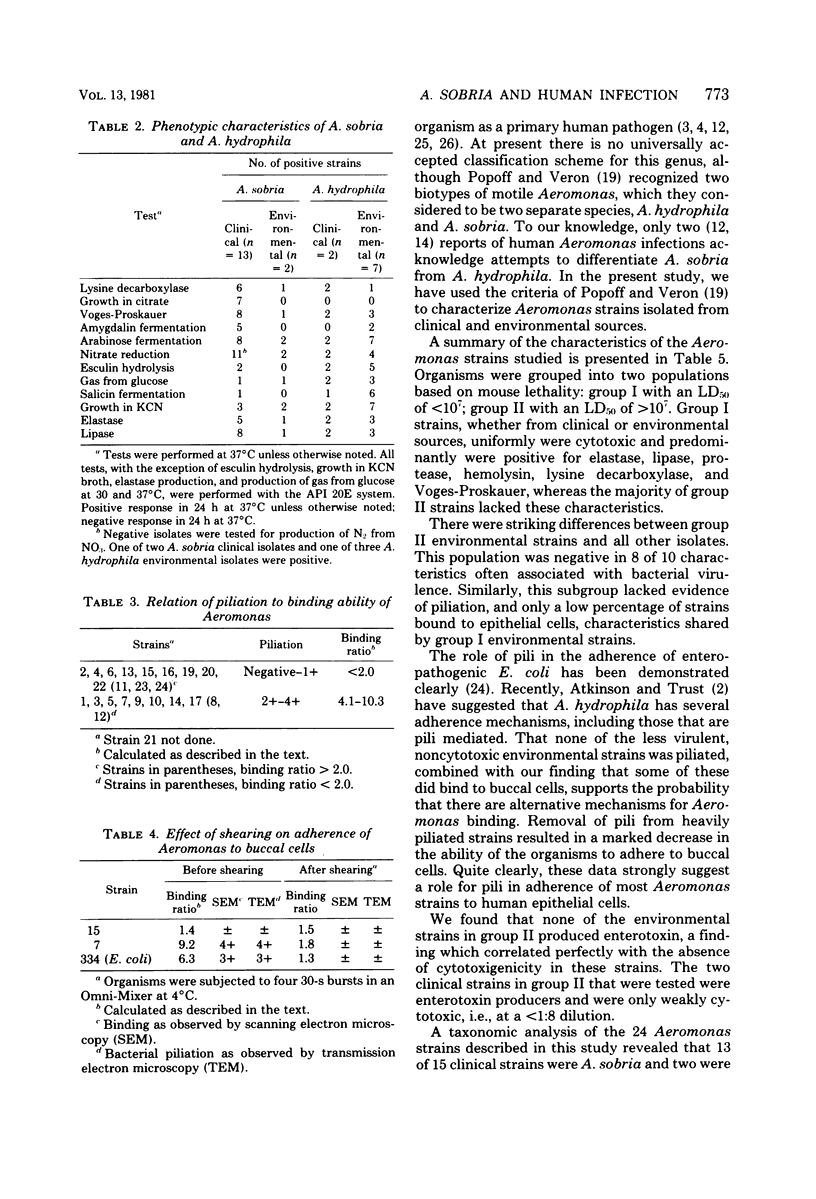



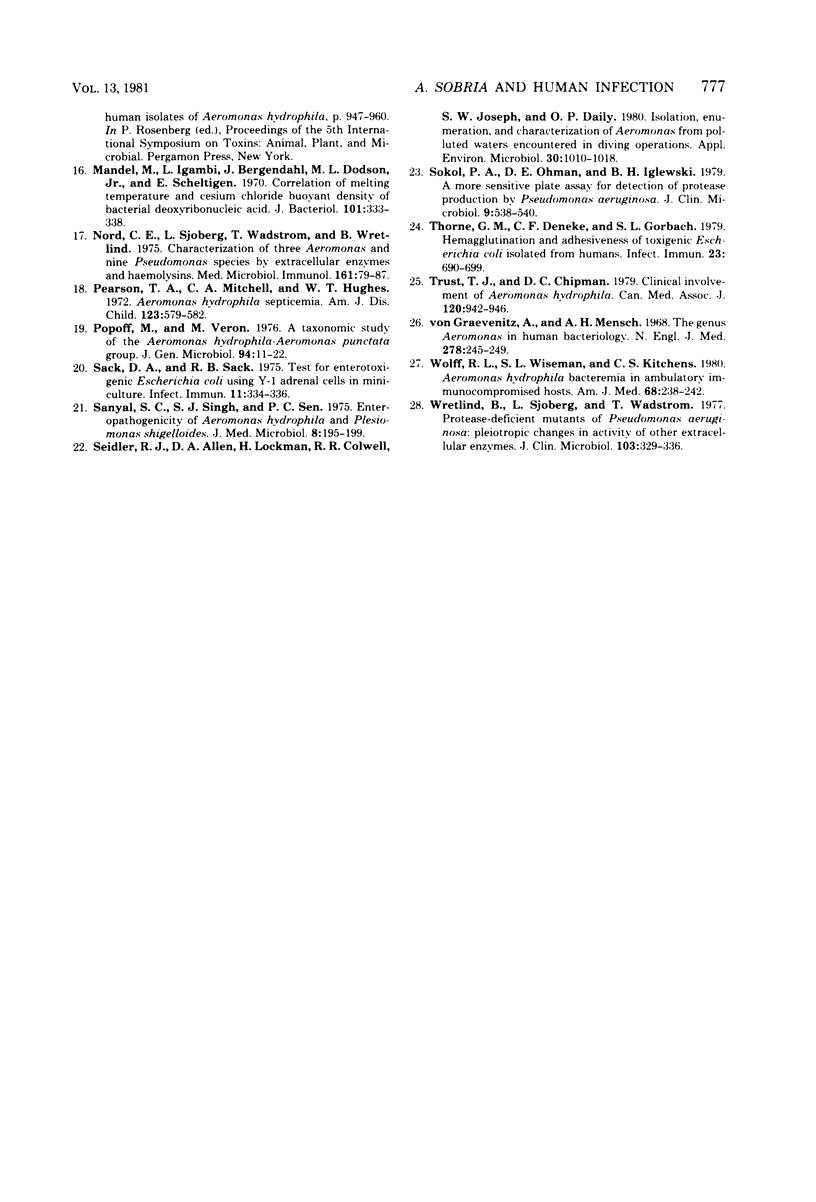
Images in this article
Selected References
These references are in PubMed. This may not be the complete list of references from this article.
- Annapurna E., Sanyal S. C. Enterotoxicity of Aeromonas hydrophila. J Med Microbiol. 1977 Aug;10(3):317–323. doi: 10.1099/00222615-10-3-317. [DOI] [PubMed] [Google Scholar]
- Atkinson H. M., Trust T. J. Hemagglutination properties and adherence ability of Aeromonas hydrophila. Infect Immun. 1980 Mar;27(3):938–946. doi: 10.1128/iai.27.3.938-946.1980. [DOI] [PMC free article] [PubMed] [Google Scholar]
- Cumberbatch N., Gurwith M. J., Langston C., Sack R. B., Brunton J. L. Cytotoxic enterotoxin produced by Aeromonas hydrophila: relationship of toxigenic isolates to diarrheal disease. Infect Immun. 1979 Mar;23(3):829–837. doi: 10.1128/iai.23.3.829-837.1979. [DOI] [PMC free article] [PubMed] [Google Scholar]
- Davis W. A., 2nd, Kane J. G., Garagusi V. F. Human aeromonas infections: a review of the literature and a case report of endocarditis. Medicine (Baltimore) 1978 May;57(3):267–277. [PubMed] [Google Scholar]
- Donta S. T., Haddow A. D. Cytotoxic activity of Aeromonas hydrophila. Infect Immun. 1978 Sep;21(3):989–993. doi: 10.1128/iai.21.3.989-993.1978. [DOI] [PMC free article] [PubMed] [Google Scholar]
- Escamilla J. Susceptibility of Haemophilus influenza to ampicillin as determined by use of a modified, one-minute beta-lactamase test. Antimicrob Agents Chemother. 1976 Jan;9(1):196–198. doi: 10.1128/aac.9.1.196. [DOI] [PMC free article] [PubMed] [Google Scholar]
- Fulghum D. D., Linton W. R., Taplin D. Fatal Aeromonas hydrophila infection of the skin. South Med J. 1978 Jun;71(6):739–741. doi: 10.1097/00007611-197806000-00037. [DOI] [PubMed] [Google Scholar]
- Hanson P. G., Standridge J., Jarrett F., Maki D. G. Freshwater wound infection due to Aeromonas hydrophila. JAMA. 1977 Sep 5;238(10):1053–1054. [PubMed] [Google Scholar]
- Johnson J. L., Ordal E. J. Deoxyribonucleic acid homology in bacterial taxonomy: effect of incubation temperature on reaction specificity. J Bacteriol. 1968 Mar;95(3):893–900. doi: 10.1128/jb.95.3.893-900.1968. [DOI] [PMC free article] [PubMed] [Google Scholar]
- Joseph S. W., Daily O. P., Hunt W. S., Seidler R. J., Allen D. A., Colwell R. R. Aeromonas primary wound infection of a diver in polluted waters. J Clin Microbiol. 1979 Jul;10(1):46–49. doi: 10.1128/jcm.10.1.46-49.1979. [DOI] [PMC free article] [PubMed] [Google Scholar]
- Joseph S. W., DeBell R. M., Brown W. P. In vitro response to chloramphenicol, tetracycline, ampicillin, gentamicin, and beta-lactamase production by halophilic Vibrios from human and environmental sources. Antimicrob Agents Chemother. 1978 Feb;13(2):244–248. doi: 10.1128/aac.13.2.244. [DOI] [PMC free article] [PubMed] [Google Scholar]
- Kaper J., Lockman H., Colwell R. R., Joseph S. W. Ecology, serology, and enterotoxin production of Vibrio cholerae in Chesapeake Bay. Appl Environ Microbiol. 1979 Jan;37(1):91–103. doi: 10.1128/aem.37.1.91-103.1979. [DOI] [PMC free article] [PubMed] [Google Scholar]
- Ljungh A., Popoff M., Wadstrom T. Aeromonas hydrophila in acute diarrheal disease: detection of enterotoxin and biotyping of strains. J Clin Microbiol. 1977 Aug;6(2):96–100. doi: 10.1128/jcm.6.2.96-100.1977. [DOI] [PMC free article] [PubMed] [Google Scholar]
- Mandel M., Igambi L., Bergendahl J., Dodson M. L., Jr, Scheltgen E. Correlation of melting temperature and cesium chloride buoyant density of bacterial deoxyribonucleic acid. J Bacteriol. 1970 Feb;101(2):333–338. doi: 10.1128/jb.101.2.333-338.1970. [DOI] [PMC free article] [PubMed] [Google Scholar]
- Nord C. E., Sjöberg L., Wadström T., Wretlind B. Characterization of three Aeromonas and nine pseudomonas species by extracellular enzymes and haemolysins. Med Microbiol Immunol. 1975;161(2):79–87. doi: 10.1007/BF02121748. [DOI] [PubMed] [Google Scholar]
- Pearson T. A., Mitchell C. A., Hughes W. T. Aeromonas hydrophila septicemia. Am J Dis Child. 1972 Jun;123(6):579–582. doi: 10.1001/archpedi.1972.02110120103012. [DOI] [PubMed] [Google Scholar]
- Popoff M., Véron M. A taxonomic study of the Aeromonas hydrophila-Aeromonas punctata group. J Gen Microbiol. 1976 May;94(1):11–22. doi: 10.1099/00221287-94-1-11. [DOI] [PubMed] [Google Scholar]
- Sack D. A., Sack R. B. Test for enterotoxigenic Escherichia coli using Y-1 adrenal cells in miniculture. Infect Immun. 1975 Feb;11(2):334–336. doi: 10.1128/iai.11.2.334-336.1975. [DOI] [PMC free article] [PubMed] [Google Scholar]
- Sanyal S. C., Singh S. J., Sen P. C. Enteropathogenicity of Aeromonas hydrophila and Plesiomonas shigelloides. J Med Microbiol. 1975 Feb;8(1):195–198. doi: 10.1099/00222615-8-1-195. [DOI] [PubMed] [Google Scholar]
- Seidler R. J., Allen D. A., Lockman H., Colwell R. R., Joseph S. W., Daily O. P. Isolation, enumeration, and characterization of Aeromonas from polluted waters encountered in diving operations. Appl Environ Microbiol. 1980 May;39(5):1010–1018. doi: 10.1128/aem.39.5.1010-1018.1980. [DOI] [PMC free article] [PubMed] [Google Scholar]
- Sokol P. A., Ohman D. E., Iglewski B. H. A more sensitive plate assay for detection of protease production by Pseudomanas aeruginosa. J Clin Microbiol. 1979 Apr;9(4):538–540. doi: 10.1128/jcm.9.4.538-540.1979. [DOI] [PMC free article] [PubMed] [Google Scholar]
- Thorne G. M., Deneke C. F., Gorbach S. L. Hemagglutination and adhesiveness of toxigenic Escherichia coli isolated from humans. Infect Immun. 1979 Mar;23(3):690–699. doi: 10.1128/iai.23.3.690-699.1979. [DOI] [PMC free article] [PubMed] [Google Scholar]
- Trust T. J., Chipman D. C. Clinical involvement of Aeromonas hydrophila. Can Med Assoc J. 1979 Apr 21;120(8):942–946. [PMC free article] [PubMed] [Google Scholar]
- Von Graevenitz A., Mensch A. H. The genus aeromonas in human bacteriology report of 30 cases and review of the literature. N Engl J Med. 1968 Feb 1;278(5):245–249. doi: 10.1056/NEJM196802012780504. [DOI] [PubMed] [Google Scholar]
- Wolff R. L., Wiseman S. L., Kitchens C. S. Aeromonas hydrophila bacteremia in ambulatory immunocompromised hosts. Am J Med. 1980 Feb;68(2):238–242. doi: 10.1016/0002-9343(80)90360-5. [DOI] [PubMed] [Google Scholar]
- Wretlind B., Sjöberg L., Wadström T. Protease-deficient mutants of Pseudomonas aeruginosa: pleiotropic changes in activity of other extracellular enzymes. J Gen Microbiol. 1977 Dec;103(2):329–336. doi: 10.1099/00221287-103-2-329. [DOI] [PubMed] [Google Scholar]




